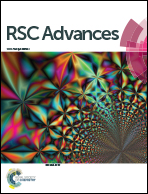Asymmetric isomerization: an efficient strategy to tune the electrical resistive memory behaviors of functional polyimides containing N-phenylcarbazole moieties†
Abstract
To elucidate the influence of spatial structure on memory behavior, three isomeric polyimides (PIs), PI-3,6-DAPCz-6FDA, PI-3,4′-DAPCz-6FDA, and PI-2′,4′-DAPCz-6FDA, for electrical memory applications are designed and synthesized. Current–voltage characteristics indicate that the three isomeric PIs display vastly deviating memory effects. PI-3,6-DAPCz-6FDA and PI-3,4′-DAPCz-6FDA both show volatile static random access memory (SRAM) behavior, while PI-2′,4′-DAPCz-6FDA exhibits a non-volatile write once read many times (WORM) memory characteristic. The mechanisms associated with the memory effect were analyzed based on molecular simulation results. PI-3,6-DAPCz-6FDA possesses the best structural coplanarity, which greatly facilitates its charge transfer (CT) and back CT process, leading to the volatile SRAM feature. However, PI-2′,4′-DAPCz-6FDA exhibits more torsional structures, which consequently prohibits the back CT process, explaining its non-volatile behavior. Additionally, the three isomeric PIs show fast transient responses. The results show the importance of the spatial structure on polymer memory and the viability of adjusting memory types by isomerization.



 Please wait while we load your content...
Please wait while we load your content...